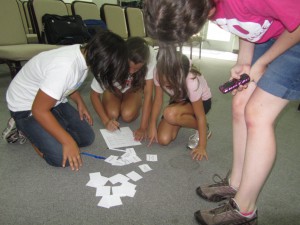by Rachel Pienta | Dec 12, 2018

Here’s an example of a decorated clothespin magnet holding a photo.
Slow Down to Savor the Season
The weeks leading up to the gift-giving holiday season can be hectic and stressful. Full social schedules and crowded stores can make Christmas seem like an expensive chore. One way to restore some of the joy of the season and regain some valuable family time is to make thoughtful giftsathome.
Craft a Gift That Everyone Can Use
Every year, the postal service brings glossy family photo cards to my home from friends near and far. Our family likes to make them part of the festive décor for the holiday season by displaying them with homemade r refrigerator magnets. This magnet craft is one you can make with your entire family or at a 4-H Club meeting and give them as gifts.

Foam board cut outs can be glued to the clothespin to make fun magnets to give as gifts.
Basic Items to Get Started
Square wooden clothespins
Glue
Scissors
Adhesive magnet strips
Craft foam sheets
Markers
Glitter
Ribbon
We have decorative magnets and like to rotate them with the season. Decorative details are limited only by your imagination and the weight that the magnets will support. Trial and error with magnet strength is recommended and is a great way to spark a STEM discussion while creating art together!
Follow these simple instructions:
- Measure the magnet strip to cover the “back” of the clothespin.
- Cut to length. (Adults may need to help younger kids with this.)
- Attach the magnet strip to the “back” of the clothespin.
- Add decorations or art work like foam cutouts to the “front” of the clothespin.
Gift Ideas
- Packaging the magnetic clothespins with a family photo or a child’s artwork.
- Using a decorated clothespin magnet to hold a gift tag and include with a larger wrapped gift.
- Giving cookies or other baked treats? Clothespin magnets make great recipe holders!
4-H is a great place for your child to express their creativity. For information about 4-H in your county, please click here.
Additional Ideas & Resources for Clothespin Magnets
DIY Clothespin Magnets!
https://www.diynetwork.com/how-to/make-and-decorate/crafts/how-to-make-refrigerator-magnets-from-clothespins
Teachers Gifts: DIY Magnetic Clothespins
by Melanie Taylor | Jun 8, 2018

Gulf and Franklin County campers shooting rockets at Camp Timpoochee in June 2017.
As the school year wraps up, you’re likely trying to fill up your child’s summer with fun and educational programs. Fortunately, you’ll find a variety of day and residential summer camps out there. Does the thought of sending your child to camp cause anxiety for your or your child? If so, let’ me give you some tips to eliminate those concerns.
First, summer day camps and residential camps can be some of the most memorable events in a child’s life. Some children make memories and friends that last a lifetime. But as a parent, you need to feel comfortable about the camp you send your child to.
When starting the camp selection process, begin with your child’s interests. Make sure you know the camp will provide activities that will enhance your child’s personality and maturity level. Including your child in the process will help them feel more secure and excited about what camp will offer them. This will also help get rid of some of their anxiety because they’ll know what to expect (especially if they have never attended camp before).
Here are questions recommended by the American Camping Association (ACA) to help you make the best summer camp decision.
Questions to Consider in Selecting a Residential Camp:
- What locale do I want to consider? (mountains, oceanfront, distance from home, etc)
- Do I want a traditional camp that gives my child a wide variety of experiences, or do I want to select a specialty camp that focuses on a particular activity or set of skills?
- What size enrollment will make my child feel comfortable?
- How rustic do I want the camp to be?
- How structured do I want the program to be? Does my child like to have lots of choice in the activity schedule?
- Is my child ready to sleep away from home for an extended stay? (This will help you to select either a resident or day camp setting.)
- What session length will appeal to my child and to our family plans for the summer? (One week? Eight weeks? Length of day?)
- How can I stay in touch with my child during camp? Does the camp allow mail, phone calls or e-mail? Does the camp have parent visitation days?
- How will the camp meet my child’s special dietary or physical needs?
- What is my budget for camp tuition? (Remember, many camps offer financial aid.)
Questions to Consider in Selecting a Day Camp:
Day camps offer experiences unique from residential camps. Because of this, there are specific points to consider when choosing a day camp – transportation, overnights, swimming lessons, food service, horseback riding, group pictures, t-shirts, extended care, field trips, etc.
- Does the American Camp Association accredit the camp? (ACA has specific standards applicable only for day camps.)
- What training does the staff receive on safety, supervision, counseling, problem solving and other issues unique to working with young children?
- Is the price all-inclusive or are there extra charges?
- If transportation is offered, where is the closest pick-up location?
- Does the camp have an “express bus” which transports children quickly?
- If before and after-camp extended care is offered, who is with the children and what activities take place?
- Is lunch served, or do campers bring their own sack lunch? Are snacks and drinks provided?
- If the camp offers swimming, are there swimming lessons, or is it simply recreational swimming?
- Are campers in a group with a counselor all day? Or, are campers free to go from one activity to another with appropriate supervision? In this case, who would you talk to if you had a question or concern about your child?
- Is an open house offered before camp starts where you can meet your child’s counselor and van/bus driver?
- Are parents allowed to drop by for visits or is there a special parent visitation day?
Along with the above questions, you should also know that in the state of Florida, summer camps are not inspected or regulated by the Department of Children and Families (DCF). This makes it even more important for parents to gather information about the quality and safety of the program on their own. Parents should check to see if they are welcome to visit and observe the camp in action or attend activities with their child at any given time including water activities.
DCF suggests you ask these questions:
- What the programs health, safety and nutrition policies and procedures?
- Is the staff screened?
- What are the staff/child ratios and group sizes of the program?
- Is the staff well-trained?
- Is the program licensed or accredited?
- Are parents welcome to visit? Are family activities offered?
- Is there a daily lesson plan?
- Is the facility adequate for the number of children enrolled?
- What are the hours of operation, fees and payment procedures?
Download the Selecting Summer Care for School-Age Children: A Quality Checklist at http://www.dcf.state.fl.us/programs/childcare/docs/SummerChecklist.pdf.
Because you should know – Florida law does require summer camps to conduct background screenings of all camp personnel, including owners, operators, employees and volunteers. Volunteers providing less than 10 hours of service per month do not need to be screened as long as they are always within sight of a person who meets the screening requirement. In the state of Florida, the camps supported by UF/IFAS Extension meet each of the standards above.
The above questions and items to consider should help you in the camp selection process. Always feel confident in asking any questions – as the parent, you have the right to feel confident in your child’s camp selection.
As you begin your summer camp search, remember to check out the day and residential camping programs offered by your local 4-H program. We are confident in our volunteers and staff competency and would love to have your child participate in our safe and fun-filled summer camps. Contact your local Extension Office for more details.
Resources for this article may be found at: www.acacamps.org and www.myflfamilies.com.
by Whitney Cherry | Dec 25, 2015

Enjoy a high-energy game of exercise bingo as you race other teams to see who can win! This game is available at your local extension office.
The New Year is upon us, and it is so fun to celebrate its coming with our families. Do you have a favorite New Year’s Tradition? If not, there is still time to plan one for this year! Here are a few fun and easy ideas to inspire you:
- New Year’s Eve Bonfire– roast hotdogs and marshmallows and enjoy hot chocolate by the fire. More family friendly campfire recipes
- Game Tournament– set up a tournament of games. You can play Minute to Win-It Style games, board games, or even electronic/video games. Each hour until midnight, let a family member choose their favorite game to play.
- Balloon Countdown– You will need a balloon for each hour of the countdown, depending on when you start. I recommend starting at 6PM, so you would need six balloons. Place a slip of paper with a craft, game or activity written on it. Place a slip in each balloon, then blow up the balloons and label each one with a number, representing each hour in the countdown until midnight. For example, at 6PM, have a family member pop the balloon with the number six on it, and then the family would do the activity listed on the slip of paper. Continue to pop balloons until midnight! Some of the activities you might include are: make paper hats, write down New Year’s Resolutions, make noisemakers, enjoy fireworks, etc.
- Progressive Hors d ’Oeuvres– this sounds fancy, but is really simple. Just prepare your family’s favorite snacks. Each hour, enjoy a different snack until midnight.
- Family Movie Night is another inexpensive favorite. Make homemade pizza or pop popcorn and enjoy a night in with your family.
- Fireworks can also be a fun activity, but be sure to read our tips on firework safety beforehand.
- Balloon Drop– a nice alternative to fireworks. Use masking tape to tape together 2 lengths of netting. Extend the tape to make a “rip cord.” Fill with balloons and confetti and tape to the ceiling (use painter’s tape so you do not damage the paint). At the stroke of midnight, pull on the rip cord and enjoy a cascade of celebratory balloons and confetti!
- And finally, you can go all in and recreate your favorite game shows. Imagine win-lose-or draw, family feud, the price is right…the possibilities are endless.
Do you have a favorite family New Year’s Eve tradition? If so, share in the comments! We want to thank you for another great year in 4-H! If you are not currently a 4-H member or volunteer, contact your local UF IFAS County Extension Office for more information, or visit http://florida4h.org for more information.

by Melanie Taylor | Dec 11, 2015
 The holidays are often filled with time-honored traditions that include some of our favorite meals and foods. As you celebrate, think of little changes you can make this holiday season to create healthier meals and active days. An added bonus, these small changes may help you to avoid those extra holiday pounds we all fear each year. Happy Cooking!
The holidays are often filled with time-honored traditions that include some of our favorite meals and foods. As you celebrate, think of little changes you can make this holiday season to create healthier meals and active days. An added bonus, these small changes may help you to avoid those extra holiday pounds we all fear each year. Happy Cooking!
In the Kitchen:
• For gravies or sauces — if you are making pan gravy, first skim the fat off pan drippings. For cream or white sauces, use fat-free (skim) milk and soft tub or liquid margarine.
• For dressings or stuffing — add low-sodium broth or pan drippings with the fat skimmed off instead of lard or butter. Use herbs and spices and a whole grain bread for added flavor.
• For biscuits — use vegetable oil instead of lard or butter and fat-free (skim) milk or 1 percent buttermilk instead of regular milk.
• For greens — use skin-free smoked turkey, liquid smoke, fat-free bacon bits, or low-fat bacon instead of fatty meats.
• For sweet potato pie — mash sweet potato with orange juice concentrate, nutmeg, vanilla, cinnamon, and only one egg. Leave out the butter.
• For cakes, cookies, quick breads, and pancakes — use egg whites or egg substitute instead of whole eggs. Two egg whites can be substituted in many recipes for one whole egg.
• Use unsweetened applesauce or mashed ripe bananas instead of butter.
• Try cutting the amount of sugar listed in recipes in half.
• Use spices to add flavor such as cinnamon, allspice, or nutmeg instead of salt.
• Try baked apples with cinnamon and a sprinkle of sugar instead of apple pie.
• Invite your guests to make their own parfait with colorful sliced fruit and low-fat yogurt.
For meats and poultry (chicken and turkey):
• Trim away all of the visible fat from meats and poultry before cooking.
• Take off poultry skin before eating.
• Broil, grill, roast, poach, or boil meat, poultry, or fish instead of frying.
• Drain off any fat that appears during cooking.
• Chill meat and poultry broth until fat becomes solid. Skim off fat before using the broth.
• Skip or limit the breading on meat, poultry, or fish. Breading adds fat and calories. It will also cause the food to soak up more fat during frying.
• Choose and prepare foods without high fat sauces or gravies.
When Shopping:
• Start with a lean choice.
• The leanest beef cuts include round steaks and roasts (round eye, top round, bottom round, round tip), top loin, top sirloin, and chuck shoulder and arm roasts.
• The leanest pork choices include pork loin, tenderloin, center loin, and ham.
• Boneless skinless chicken breasts and turkey cutlets are the leanest poultry choice.
Use the food label to help you choose
• Choose extra lean ground beef. The label should say at least “90% lean.” You may be able to find ground beef that is 93% or 95% lean.
• Processed meats such as hams, sausages, frankfurters, and luncheon or deli meats have added sodium. Check the ingredient and Nutrition Facts label to help limit sodium intake.
• Fresh chicken, turkey, and pork that have been enhanced with a salt-containing solution also have added sodium. Check the product label for statements such as “self-basting” or “contains up to __% of __.”
• Lower fat versions of many processed meats are available. Look on the Nutrition Facts label to choose products with less fat and saturated fat.
De-Saturate
• Use a nonstick pan with vegetable cooking oil spray or a small amount of liquid vegetable oil instead of lard, butter, shortening, or other fats that are solid at room temperature.
Enjoy the Food, Fun, Friends and Family!
Cheers to Good Health
• Quench your thirst with low-calorie options. Drink water with lemon or lime slices. Offer seltzer water with a splash of 100% fruit juice.
Be the Life of the Party
• Laugh, mingle, dance, and play games. Focus on fun and enjoy the company of others.
Give to Others
• Spend time providing foods or preparing meals for those who may need a little help. Give food to a local food bank or volunteer to serve meals at a shelter during the holiday season. Giving back is a great mood booster.
Make Exercise a Part of the Fun
• Make being active part of your holiday tradition. Have fun walking and talking with family and friends after a holiday meal. Give gifts that encourage others to practice healthy habits such as workout DVDs, running shoes, and reusable water bottles.
Enjoy the Leftovers
• Create delicious new meals with your leftovers. Add turkey to soups or salads. Use extra veggies in omelets, sandwiches, or stews. The possibilities are endless!
Be sure your family and friends enjoy the food and fun, but focus on the time together. Remember this season is all about the memories, not just the food. You will feel better and enjoy your holiday time with less worry if you focus on staying healthy this season.
Source: USDA United States Department of Agriculture – www.MyPlate.gov
by Melanie Taylor | Sep 11, 2015

Packing the kids’ lunches for school means you know which nutritious foods they are eating. Here are some budget-friendly, creative ideas to keep kids happy and healthy at lunchtime.
Make a “Smarter” Sandwich:
While some kids prefer the same thing every day, others may be okay with a slight switch to their sandwich.
- Use different breads like 100% whole wheat tortilla wraps (choose wraps low in saturated and made with no hydrogenated oils) or 100% whole wheat pita pockets.
- Besides lettuce, try shredded carrots or avocado slices with a turkey sandwich.
- Buy blocks of low fat, low-sodium cheeses. You save money when you slice it yourself. Or use a cookie cutter to cut into fun shapes.
- Instead of lunch meat, try a leftover grilled chicken sandwich with lettuce and tomato.
Love Those Leftovers:
Try using the leftovers from the family dinner for the next day’s lunch. Invest in a thermos to keep foods hot or cold until lunchtime.
- Low-sodium tomato, vegetable or bean soups
- Chili made with lean or extra lean ground turkey
- Whole wheat spaghetti with low sodium tomato sauce
- Low-sodium baked beans, bean casserole or beans & rice
Let Them Dunk:
Sometimes it is okay to let your kids play with their food, especially when they are getting extra nutrition.
- Apple and pear slices to dip into low-fat plain yogurt mixed with peanut butter.
- Carrot, celery and sweet pepper strips to dip into hummus, fresh salsa or homemade bean dip.
- Whole grain crackers (choose crackers low in sodium and saturated fat and made without hydrogenated oils) to dunk into low-sodium vegetable or tomato soup.
- Unsalted sunflower seeds, crushed whole wheat cereal and sliced banana to mix into low fat vanilla yogurt (no added sugars) to eat with a spoon like a sundae.
Get Them Involved:
While letting kids in the kitchen might mean a bigger mess, if they help pack their own lunch, they are more likely to eat it! On nights you have a bit more time, like a Sunday night, have them choose which piece of fruit or what type of whole grain bread they want and let them assemble their lunch. Make this a weekly routine – it’s another great way to spend family time together.
For more heart healthy lunch tips visit: www.heart.org






